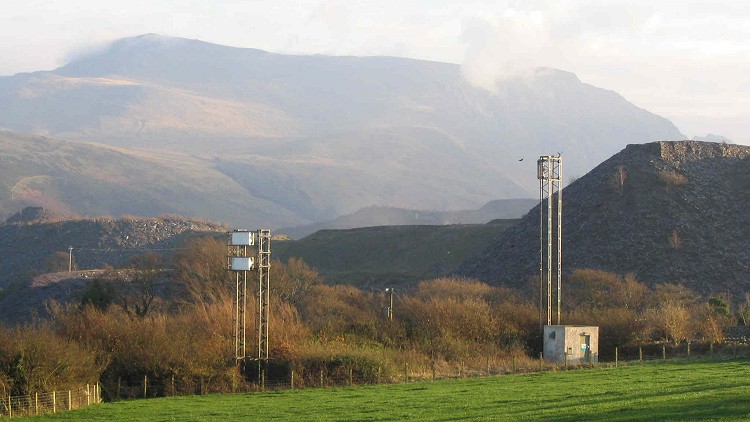 |
UK Broadcast Transmission |
|
|||||||||||
THE TRANSMISSION GALLERY
BETHESDA
| Photos by Ray Cooper & Mat Overton, text by Ray Cooper | Page last updated: 2021-12-29 |
| Bethesda was originally a BBC landlord site which entered service with BBC 2 in May 1971. BBC 1 was added in April 1973, ITV from September 1973, with S4C available from the 1st November 1982 launch. DSO was on 21st October and 18th November 2009. |


| Bethesda is what is known as an 'Active Deflector' - the signals from the parent station are simply amplified and re-radiated, without any frequency change being involved. In order for this rather dubious practice to succeed, a number of conditions have to be met: A good aerial installation. Consider an 'ordinary' relay station. The receiving aerial, looking at the parent station, is usually mounted on the same mast as the transmitting aerial - often quite close. Hence, there is a lot of transmitted signal picked up by the receive aerial. This doesn't matter, for the first item after the receive aerial is a filter which accepts the parent signal but rejects the transmitted one. |


| Unfortunately, on an active deflector, the input filter has to be tuned to the same frequency as the output signal! This means that output signal rejection has to be done some other way. There are several steps, all of which will probably be necessary: 1. You need aerials which have a good front-to-back ratio * 2. You need to install the receive aerial in such a position that the transmit aerial is (more or less) well behind the receive aerial. 3. You need a good physical separation between the two, to take advantage of the inverse square law. 4. You use cross-polarisation of the aerials - this can give you an extra 8dB of rejection at the relay station site, and of course benefits viewers in the target area as well. * even a 'good' receiving aerial, such as the GD2000 log-periodic aerials customarily used on relay sites, are nothing like good enough. The only thing that seems to work is the standard trough-aerial used for RBL and RBS links on main stations. These have a solid-metal back and are exceedingly well screened. If the overall isolation between aerials is too low, the picture becomes degraded with 'ringing' and ghosting effects. If it is much too low, the entire installation oscillates in an uncontrolled manner much like a badly-installed public address system. |

| A good amplifier The original units used at this site were an adaptation of the BBC EP7/513 transposer (colloquially known as the 'wine press', due to its mechanical layout). This was a unit not to everyones taste. In these units, there was often not an IF at all: the incoming signal frequency was simply mixed to the output frequency using a mixer and local oscillator. Occasionally, to get proper channel offsets, double mixing was used with an extra mixer and oscillator. The important item to note was that at all times the signal was at (some or other) UHF TV channel. In the active deflector version (not coded /513, but differently. /520? I can't remember) the mixer and local oscillator units were simply omitted, and the signal blew through the unit unimpeded at the same frequency. When you stop and think that the input to the amp. was probably about -40dBm and the output +33dBm, you needed between 70 and 80dB of gain in the amp, all at the same frequency. Hence, the units making up the amp. had to be exceedingly well screened to avoid instability. I think it fair to say that the original units barely made this requirement, and increasing age and corrosion made things worse. The original units were replaced by more modern designs by the time S4C came along. The right site Obviously, the receive aerial needs a good view of the parent, and the transmit one of the target viewers, but in addition there must be no objects in the vicinity which, illuminated by the transmit aerial, can reflect back into the receive aerial. This implies a clear and (preferably) down-sloping site towards the target. In addition to this, the viewers need to be in a favoured location. They must be screened from signals arriving directly from the parent station, else ghosting will occur on a majestic scale. The Bethesda site meets most of these requirements. The target audience is (mostly) in a slight side-valley, screened from the parent by a rock hillside. In addition, cross-polarised signals from the parent station arrive at the target aerials at about 90 degrees to the forward beam, so there is additional rejection due to side-nulls. However, there are areas of the town that do get too much signal from the parent, and where the relay is not usable. Unfortunatey, the parent is not useable either, due to the strong signal from the relay. This is the reason for the provision of the Bethesda North relay, which uses conventional channel-changing tactics. |

| I often wonder why they made Bethesda an active deflector. The usual reason is that there are no available channels for a conventional relay. This is manifestly not the case here: I think they did it just to see if it could be done! The site is almost ideal, and such favourable geographical factors are not very common |
Link to BBC Engineering Publication, see pg 36 onwards
| |
Back to TX Gallery index | TX main index
|